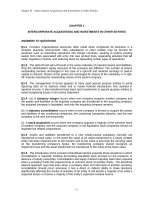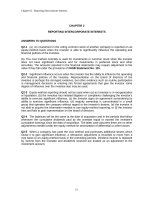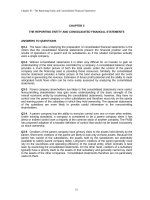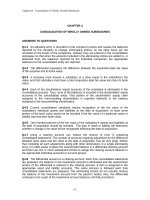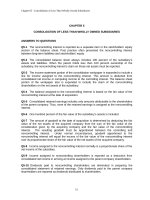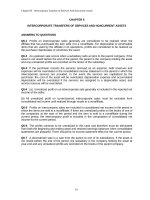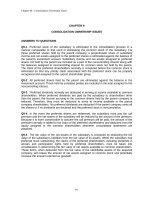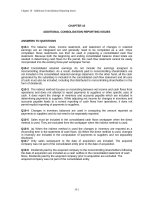Solution manual advanced financial accounting, 8th edition by baker chap019
Bạn đang xem bản rút gọn của tài liệu. Xem và tải ngay bản đầy đủ của tài liệu tại đây (196.55 KB, 50 trang )
Chapter 19 - Not-for-Profit Entities
CHAPTER 19
NOT-FOR-PROFIT ENTITIES
ANSWERS TO QUESTIONS
Q19-1 Initially, tuition scholarships are included in revenue for the period in order to
measure fully the revenue obtainable. If the university requires an employment-type
work for the tuition scholarship, then they are also shown as an expense. However, if
no employment-type work is required of the recipient, then the university also records
the tuition scholarship as a revenue-reduction item.
Q19-2 In the statement of financial position for private colleges, the net assets are
designated as (1) unrestricted, (2) temporarily restricted, or (3) permanently
restricted. Permanently restricted assets result from contributions that the donors
have specified must be retained into perpetuity. Earnings from the principal are then
used in accordance with the wishes of the donor. Temporarily restricted assets are
those which the donor has contributed for specific use or which have been
contributed for use in a future period. All other assets are classified as unrestricted.
Q19-3 The accounting and reporting for public universities is specified by the GASB,
and GASB 35 provides specific guidance that public universities should be accounted
for as special-purpose governments in accordance with GASB 34. Private
universities have their accounting and financial reporting specified by the FASB.
FASB 117 provides the format and requirements for financial reporting for private
universities.
Q19-4 The accrual basis of accounting is used in a hospital's general and restricted
funds. Donor restricted contributions are held in the restricted fund until the conditions
are met and then are transferred to the general fund.
Q19-5 Donated services are included as a revenue and a corresponding expense at
their fair value if the services are significant and would otherwise be performed by
salaried personnel. The criteria for recognition require that the services either (a)
create or enhance the nonfinancial assets of the hospital or (b) the services provided
require specialized skills, are provided by individuals possessing those skills, and
would need to be purchased if not provided by donation. Donated equipment is
accounted for as a contribution in a temporarily restricted fund until placed into
service, at which time it is transferred to the general fund. Donated medical supplies
are recorded as revenue and charged to expenses as used.
Q19-6 The $15,000 is accounted for as a contribution to a specific purpose
restricted fund. When the $15,000 is expended by the general fund, the specific
purpose restricted fund transfers the resources to the general fund to reimburse the
general fund or pay for the intensive care operating expenses. The expense is
reported as an expense of the general fund and the reimbursement from the
restricted fund is reported as net assets released from the restricted fund.
Q19-7 Net patient service revenue of a hospital is computed by deducting
contractual adjustments from total billings for inpatient and outpatient services
provided. Charity care is excluded.
19-1
Chapter 19 - Not-for-Profit Entities
Q19-8 The general fund records a gain on the sale of hospital properties. The gain is
reported in the hospital's statement of activities.
Q19-9 Depreciation is recorded on an accrual basis by hospitals. It must be
accounted for because depreciable assets constitute a significant part of the total cost
of providing medical services.
Q19-10 The accrual basis of accounting is used for the unrestricted current fund of a
VHWO. The accrual basis of accounting is also used for all other funds, including the
restricted current fund, the land, building, and equipment fund (plant fund), and the
endowment fund.
Q19-11 If separate funds are maintained, fixed assets are recorded in the land,
building, and equipment fund (plant fund) in a VHWO. If separate funds are not
maintained, fixed assets would be recorded in the unrestricted fund along with all
other assets.
Q19-12 The $10,000 contribution is accounted for as contribution revenue in a
temporarily restricted (specific purpose) fund when it is received. The expense of the
$10,000 for public health education service is accounted for as a program services
expense of the unrestricted fund and as a net asset released from the temporarily
restricted fund.
Q19-13 Pledges from donors that are unconditional promises to give are recognized
as contribution revenue in the period in which the pledge is received. Although the
total amount of the pledge is recorded as a contribution receivable, an adequate
allowance for uncollectibles must be recognized. The estimated amount that actually
will be collected is recognized as contribution revenue. Pledges applicable to future
periods or restricted in use by the donor should be recorded in the temporarily
restricted or permanently restricted fund, as appropriate.
Q19-14 It would not be appropriate to report funds whose use is restricted as
revenue in the unrestricted fund prior to the time the restriction was met.
Contributions that must be permanently retained are included as contribution revenue
in the permanently restricted fund. Those received with restriction as to use or that
must be used in a future time period are recorded as contribution revenue in the
temporarily restricted fund(s).
Q19-15 Many VHWOs are heavily dependent upon donated services. However, such
services typically are not recorded and included for financial reporting purposes. For
example, neighborhood solicitations are an integral part of the activities of many
charitable organizations but no accounting recognition is given for these efforts. To
be recognized, donated services must (a) create or enhance nonfinancial assets or
(b) require specialized skills, be provided by individuals possessing those skills, and
typically be purchased if not provided by donation.
If these conditions are satisfied, the value of the donated services received should be
reported as part of revenue and public support and the cost of the services
recognized as an expense item of the period.
19-2
Chapter 19 - Not-for-Profit Entities
Q19-16 The statement of functional expenses details the items reported in the
expense section of the statement of activities. The individual expense categories
generally are assigned to each major programmatic activity and to general
management and efforts. As a result, much greater insight can be gained into the way
in which funds are spent. Voluntary health and welfare organizations are required to
prepare a statement of functional expenses.
Q19-17 The contribution of $12,000 is accounted for as a contribution of a
temporarily restricted net asset at the time of receipt. When the expense of $12,000 is
made for a community service activity, the amount used is recognized as funds
released from program use restrictions in the statement of activities.
Q19-18 All organizations subject to FASB jurisdiction must meet the qualifications for
recognition of contributed services set forth in FASB 116. Thus, most hospitals and
ONPO will be expected to account for donated services in the same manner. Both
hospitals and ONPOs must demonstrate that the services received either (a) created
or enhanced nonfinancial assets or (b) required specialized skills, were provided by
individuals possessing those skills, and would have been purchased if the services
had not been contributed. ONPOs also have been required to demonstrate that the
services of the ONPO were not principally intended for the benefit of the
organization's members in the past. As a result, ONPOs seldom have recorded
donated services. If donated services are recognized, an ONPO records them as
public support; hospitals recognize donated services as revenue.
Q19-19 The market value unit method of accounting for investments may be used for
pooled investments. Under this method, a fund is assigned a number of units based
on the fund's contribution to the pool and the total market value of all investments in
the pool at the time of the contribution.
Q19-20 As an ONPO, a Rotary Club should record depreciation expense because
the omission of depreciation would result in an understatement of the costs of
providing the organization's services.
Q19-21 The statement of activities for both an ONPO and VHWO reports the
support, revenue, expenses, net assets released from restriction, and changes in net
assets during the fiscal period. The particular items reported and the size of the
various revenue and expense categories may vary rather substantially between such
entities, however, due to differences in the overall missions and types of activities the
organizations are involved in on a routine basis.
Q19-22 Temporarily restricted contributions of ONPOs would include funds for
specific programs such as sponsoring a child to summer camp, purchasing reading
materials for vacation church school, or acquiring manuscripts for a research library.
Permanently restricted funds require the creation of an endowment with the principal
to be held intact. Examples would be the creation of an endowment with the earnings
to be used to help underwrite the cost of bringing in one or more large symphonies
each year to perform at a local concert hall, to provide for landscaping and lawn
service at a local cemetery, or to assist in recruiting and training new Girl Scout
leaders.
19-3
Chapter 19 - Not-for-Profit Entities
SOLUTIONS TO CASES
C19-1 Accounting for Donations
a. Donated services are a vital element of many not-for-profit entities, including
hospitals, voluntary health and welfare organizations and other not-for-profit
organizations. The criteria established in FASB 116 for recognition of donated
services require:
1.
The services performed create or enhance nonfinancial assets or,
2.
The services (a) require specialized skills, (b) are provided by individuals
possessing those skills, and (c) the services would be purchased if not
donated.
In general, donated services are not recognized unless they represent an important
contribution to the operations of the organization. For example, in the hospital setting,
a volunteer who staffs a nursing station on a regular shift but accepts no
compensation clearly provides services which meet the criteria for recognition. The
hospital would need to hire another nurse if these services were not volunteered.
Moreover, the hospital has the ability to supervise and directly control the activities of
the volunteer in the same manner as a paid employee. On the other hand, a group of
high school youth who visit patients and attempt to make their stay in the hospital
more pleasant would not qualify for recognition. If the services were not provided it is
unlikely the hospital would use its resources to hire staff to perform this function.
Voluntary health and welfare organizations often receive donated services for
concentrated fund raising efforts and for supplementary programs. Because of the
difficulty in determining the value of these services and the absence of controls over
the persons providing the services, VHWOs normally do not account for donated
services unless the first three criteria are met. Even when these are met, it may be
appropriate to recognize the donated services only if the amount of time donated is
significant and represents an integral part of the activities provided by the
organization.
Other not-for-profit organizations often rely heavily on donated services as well.
However, many of these are for the benefit of other members rather than for some
general public purpose and there has been reluctance to recognize donated services
in the financial statements. In many cases the services are not under the direct
control of the organization and are very difficult to value.
b. Donations of capital assets are recorded as a contribution in a restricted fund and
carried in the fund until the asset is placed into service, at which time it is transferred
to the general fund. The donation is recorded at its fair value. Once the asset is
placed in service, depreciation is recorded for the use of the asset in order to
measure fully the cost of providing the hospital's services.
19-4
Chapter 19 - Not-for-Profit Entities
C19-1 (continued)
c. As in all not-for-profit organizations, the accounting for cash contributions to a
hospital depends on whether or not the donor places a restriction on the use of the
cash. If the gift is unrestricted, it is accounted for as contribution revenue in the
general fund. If the gift is restricted, it is recorded as a contribution of temporarily
restricted or permanently restricted net assets. In the period in which the restriction is
met, the appropriate amount is reported in the general fund as released from use or
passage of time restriction.
Cash contributions to a voluntary health and welfare organization or an other not-forprofit organization are accounted for as public support in the period the contribution is
received as an addition to unrestricted or restricted net assets. If the contribution is
restricted by its donor, the gift is treated as a contribution of a temporarily restricted or
permanently restricted net asset at the time of receipt and then reported as released
from restriction in the period in which the restriction is met.
C19-2 Public Support to an Other Not-for-Profit Organization
a. The $25,000 of unrestricted contributions should be accounted for as public
support revenue in the statement of activities for the current period.
b. The $15,000 of restricted contributions should be accounted for as a temporarily
restricted asset in the restricted fund, if a restricted fund is used or in the general fund
if a separate restricted fund is not maintained. The $15,000 should be recorded as a
contribution in the period of receipt. The expense of $6,000 for public health
advertisements triggers recognition of $6,000 as funds released from a use restriction
with both the expense and release of funds included in the statement of activities for
the period. If a separate temporarily restricted fund is maintained and the $6,000
expense is made from the unrestricted operating fund, the restricted fund would then
reimburse the unrestricted fund for its expenses. It does not matter that unrestricted
assets were used for the actual expense.
The remaining $9,000 of restricted resources should be reported as a part of its
temporarily restricted net assets on the ONPO's balance sheet.
19-5
Chapter 19 - Not-for-Profit Entities
C19-3 A Brief Analysis of the Financial Disclosures of United Way of America
The United Way of America’s (UWA) web site is www.unitedway.org. The navigation
to the consolidated financial statements and Form 990 (the form that the IRS requires
tax exempt charitable organizations to file) is as follows: (Click on each of the
following, in turn) 1.) About United Way; 2.) United Way of America; 3.) Financial Info
(990); and then you will be at the links for the Form 990 and the Consolidated
Financial Statements and Supplemental Schedule.
The most recent year of availability will provide the specific data for the questions, but
the following are general answers to the questions in the case.
a. From footnote 1 of the Consolidated Financial Statements: The reporting entity
includes the following: United Way of America (UWA) and its subsidiaries, United Way
Store and United eWay. The statements also include UWA’s regional office of United
Way of Tri-State, Inc. Operationally, the United Way Store is a for-profit subsidiary to
provide sales fulfilment services to UWA and other organizations. United eWay
provides on-line giving along with pledge processing and fund distribution services for
corporations working with UWA. In June 2005, United Way of Tri-State, Inc (UWTS)
became a Tri-State Regional office of the UWA and is responsible for raising
charitable funds and working with companies whose employees live and/or work in
the New York Tri-State region. And there are a large number of local United Way
chapters that manage local fund raising campaigns.
b. The Consolidated Statements of Financial Position includes eliminations for intraorganizational payables and receivables (Due from affiliates and Due to affiliates) and
the capital accounts of the for-profit United Way Store (against the investment in
subsidiary account of the parent, UWA. These eliminating entries are the same type
as in the consolidating workpaper used for a parent and its subsidiary companies as
presented in the first ten chapters of this textbook.
The major components of the consolidated assets and equity will depend on the
specific year analyzed. Because UWA is an organization that focuses on raising and
distributing charitable funds, the consolidated statement of financial position will
reflect unrestricted and restricted amounts, custodial funds (both as an asset and a
liability), campaign receivables, and fixed assets such as building, land, and
equipment.
The custodial funds are described in footnote 1. UWA is the fiscal agent for a Federal
Emergency Management Agency (FEMA) program to distribute federal funds through
the Emergency Food and Shelter (EF&S) program which is not consolidated into
UWA’s financial statements. UWA is the custodian of the federal funds and
distributes these funds in accordance with the directions of the national board
established to determine needs that can be met with these funds. Thus, UWA reports
both an asset and a liability in the same amount for any undistributed funds for which
it is the custodian.
c. The consolidated statement of activities shows the typical types of revenues and
expenses of a large fund raising not-for-profit entity. Revenues will include public
support through membership, campaigns, and contributions. Also, United Way Stores
generates revenue from sales of promotional materials. Expenses include program
services, particularly Public Policy, which footnote 1 describes as federal advocacy
efforts and coordination of national activities at the regional level, and crisis response.
19-6
Chapter 19 - Not-for-Profit Entities
C19-3 (continued)
The total consolidated fund raising expenses are included in supporting services. In
2006, these costs were $577,000, which is a relatively small percentage of total
expenses as compared with other fund raising not-for-profit entities. UWA has
successfully worked with a large number of businesses and other entities to
coordinate UWA fund raising activities in those entities. Thus, the businesses and
other entities provide a relatively large part of UWA’s fund raising efforts.
d. The supplementary schedule of functional expenses presents expense
information on each of the program services described in footnote 1 of the
consolidated financial statements. Public policy is generally the largest, followed by
brand leadership, investor relations, Center for Community Leadership and
community impact leadership.
Note that supporting services are presented
separately from program services.
The three largest expense categories are scholarships, grants, and awards (primarily
given through the public policy program); salaries, and professional fees and contract
services (across all program services and supporting services, but especially under
brand leadership).
e. Form 990 contains much of the same information as provided in the consolidated
financial statements, but in a format that permits the IRS to easily compare
information for tax-exempt organizations. Most students will not have seen a Form
990 before this case and can quickly see that Form 990 can be prepared from
information from the consolidated financial statements.
19-7
Chapter 19 - Not-for-Profit Entities
C19-4 Case on Conditional Gift to a Not-for-Profit Organization
MEMO
To:
Betty Gardner, Treasurer, Central Illinois Chapter
From:
Re:
, CPA
Victor Wyatt pledge
Mr. Wyatt has pledged $20,000 per year for five years to the Central Illinois Chapter,
with the condition that the chapter sponsor annual educational programs over the
next five years. Mr. Wyatt’s pledge should be considered as a conditional promise to
give, under the requirements stated in paragraph 22 of FASB Statement No. 116.
The first $20,000 gift, which has already been received by the chapter, should be
recognized either as a contribution or as a refundable advance, depending on
whether the conditions associated with the contribution have been substantially met.
[FASB 116, Par. 22] Because the first educational workshop has been organized and
scheduled and has been approved by Mr. Wyatt, I believe that this amount can be
recognized as a contribution during the current fiscal year.
Although the chapter does intend to fulfil Mr. Wyatt’s conditions in order to receive the
additional contributions, at this point in time these conditions are not substantially
met. Therefore, the additional $80,000 that Mr. Wyatt has pledged should not be
recognized in the current fiscal year. Mr. Wyatt has clearly stated that the additional
contributions will not be made if the chapter does not continue with the educational
programs. Thus there is no ambiguity about whether Mr. Wyatt’s promise to give is
conditional or unconditional.
Determining whether a promise is conditional or unconditional can be difficult if it
contains donor stipulations that do not clearly state whether the right to receive
payment or delivery of the promised assets depends on meeting those stipulations.
It may be difficult to determine whether those stipulations are conditions or
restrictions. In cases of ambiguous donor stipulations, a promise containing
stipulations that are not clearly unconditional shall be presumed to be a conditional
promise. [FASB 116, Par. 23]
Although the chapter cannot recognize the $80,000, the pledge should be disclosed.
The chapter should disclose the following with respect to Mr. Wyatt’s conditional
promise:
a. The total of the amounts promised, and
b. A description and amount for each group of promises having similar
characteristics, such as amounts of promises conditioned on establishing new
programs, completing a new building, and raising matching gifts by a specified date.
[FASB 116, Par. 25]
Primary references
FASB 116, Par. 22
FASB 116, Par. 23
Query Used
condition* gift*
condition* giv*
Other references
19-8
Chapter 19 - Not-for-Profit Entities
FASB 116, Par. 25
FASB 116, Par. 79
19-9
Chapter 19 - Not-for-Profit Entities
C19-5
Accounting for Contributions to and Activities of a Not-for-Profit
Organization
MEMO
To:
Gerry Finley, Manager
From:
Re:
, CPA
Auction Extravaganza
There are two different problems with the way that the Community Chest is reporting
the proceeds of the Auction Extravaganza event. First, paragraph 24 of FASB
Statement No. 117 (FASB 117) requires that the revenues and expenses from the
event be reported as gross amounts and should not be netted together.
Although FASB 117 does permit net reporting for investment income or gains from
certain peripheral activities [FASB 117, Par. 24-25], these exceptions do not apply to
a major event like the Auction Extravaganza. Therefore, the statement of activities
should include the gross revenue from the event in the revenues section and should
identify the event expenses in the expense section of the statement.
The second accounting issue is the donations that the Community Chest receives for
the Auction Extravaganza event. Community Chest is recording as revenue the event
ticket sales and the auction proceeds but is not reporting donated auction items and
services as contributions. In paragraph 5 of FASB Statement No. 116 (FASB 116),
contributions received by a not-for-profit organization are defined as an unconditional
transfer of cash, other assets, or services.
The items that businesses donated to be auctioned meet the definition of
contributions. FASB 116 provides that contributions received are to be recorded at
fair value. [FASB 116, Par. 8] Because the donated items are immediately used by
the Community Chest in the auction, the fair value of the items should be estimated
and recognized as both a revenue and an expense in the current reporting period.
Contributions received shall be recognized as revenues or gains in the period
received and as assets, decreases of liabilities, or expenses depending on the form
of the benefits received. [FASB 116, par. 8]
The Community Chest should also estimate a fair value for the services provided by
the auctioneer and the musicians. These meet the requirement for recognition that
the services are specialized skills that the Community Chest would have to purchase
if the donation was not made. [FASB 116, Par. 9] Again, since the services are both
donated to and consumed in the Auction Extravaganza, the fair values should be
recognized as both revenue and expense.
Although these changes will have no net effect on the change in net assets reported
in the statement of activities, they will provide more complete information about the
Auction Extravaganza event, which complies with the FASB’s intent in issuing FASB
116.
Primary references
FASB 117, Par. 24
profit
Other references
FASB 116, Par. 9
19-10
Query Used
revenue* expense* net* not-for-
Chapter 19 - Not-for-Profit Entities
FASB 116, Par. 5
FASB 116, Par. 8
FASB 116, Par. 72
contribution*
contribution* service*
C 19-6 An Analysis of the Financial Statements for the American Red Cross, a
Voluntary Health and Welfare Organization
a. Read the independent auditor’s report of the U. S. Army Audit Agency that is
disclosed in the annual report of the American Red Cross (ARC). In this report, it
states that “The Act of Congress that incorporated the American Red Cross, as
implemented by Department of Defense Directive 1330.5 and Army Regulation
930.5, requires the U. S. Army Audit Agency perform an annual audit of the
financial statements of the American Red Cross.”
b. Look at the statement of functional expenses for the most recent year. This
statement is a required financial statement for the ARC. From this financial
statement, you can determine the ratio of program expenses to total expenses for
the most recent year. The ratio of program expenses to total expenses for the
ARC has been around the 90% level. This ratio is substantially better than the
60% threshold recommended by the Better Business Bureau.
c. Read the revenue recognition note. In this note to the financial statement, the
ARC reports that “Contributions, which include unconditional promises to give
(pledges) are recognized as revenues in the period received or promised.” To
answer the question on the amount of temporarily restricted contributions
receivable as of the most recent balance sheet date, you should look at the
consolidated statement of financial position. On this statement, the portion of
temporarily restricted contributions receivable that are reported under current
assets should be added to the temporarily restricted contributions receivable that
are reported under noncurrent assets to get the answer.
d. Read the note on net assets. In this note, the amount of unrestricted net assets
that are undesignated by the Board of Governors at June 30 of the most recent
year is disclosed.
e. Read the note on contributions receivable. In this note, the discount rate used to
present value long-term pledges is disclosed.
f. Look at the consolidated statement of activities for the most recent year. On this
statement, the ARC reports the amount “net assets released from restrictions.”
This is the amount that was reclassified from temporarily restricted net assets to
unrestricted net assets due to satisfaction of purpose and/or time restrictions.
g. Look at the statement of functional expenses for the most recent year. In past
years, Biomedical has had the highest total cost for salaries and wages and
employee benefits.
h. Read the note on organization and basis of presentation. In this note, temporarily
restricted net assets are those “net assets subject to donor-imposed restrictions
on their use that may be met either by actions of the Organization or the passage
of time.”
19-11
Chapter 19 - Not-for-Profit Entities
i.
Read the note dealing with contributed services and materials. In this note, you
will find the amount of contributed service revenue that was reported for the most
recent year.
C19-6 (continued)
j.
Read the note on contributions receivable. In this note, the ARC reports the
amount of conditional contributions at the end of the most recent year. Conditional
contributions are not reported as revenues for the current year because the
conditions have not been met. After the conditions are met, the contributions will
become unconditional and revenue will be reported.
k. Read the note on investments. In this note, the amount of dividend and interest
revenue for the most recent year is reported for all three net asset categories.
l. In the past, the ARC disclosed that its unrelated business income came from the
following sources:
• Rental income;
• Parking garage;
• S-corp income; and
• Charitable gaming.
m. Read the note on revenue recognition. In this note, it states that “When a donor
restriction expires, that is, when a stipulated time restriction ends or purpose
restriction is accomplished, temporarily restricted net assets are released and
reclassified to unrestricted net assets in the consolidated statement of activities.”
n. Read the note on revenue recognition. In this note, it states that “Donor-restricted
contributions are initially reported in the temporarily restricted net asset class,
even if it is anticipated such restrictions will be met in the current reporting
period.”
o. Read the note on contributed services and materials. In this note, it states that “…
in the absence of donor-imposed restrictions, gifts of long-lived assets are
reported as unrestricted revenue.
19-12
Chapter 19 - Not-for-Profit Entities
C19-7 An Analysis of the Financial Statements of the University of Notre Dame,
a Private University.
The specific answers your students provide for the questions will depend on the most
recent year for which the annual report is provided on university’s web site. The
following are general guidance for the answers to the questions.
a. In the notes to the financial statements, read the note on restricted net assets and
endowment. In this note, temporarily restricted contributions received for
buildings and equipment is disclosed for the most recent year.
b. Read the note that contains a summary of significant accounting policies. In this
note, the University states “Non-operating activity in the statements of changes in
unrestricted net assets includes unrestricted contributions from bequests
designated by the University for endowment and acquisition of physical facilities
and equipment, investment return in excess of or less than the amount distributed
under the spending plan, any gains or losses on other financial instruments, net
assets released from restrictions designated for investment and physical facilities,
and other activities considered to be more of an unusual and non-recurring
nature.”
c. Read the most recent statements of changes in unrestricted net assets. On this
statement, net assets released from restrictions are disclosed in two places – (1)
the operating section and (2) the Nonoperating section. This question asks for
the amount of net assets released from restrictions for operations.
d. Read the note on land, buildings, and equipment. In this note, the University
states that it “…does not capitalize…the cost or fair value of its art collection.”
e. Read the note that discloses the summary of significant accounting policies. In
this note, read the section that deals with contributions. In this note, it states that
“Contributions to be received in future years are discounted at a U. S. Treasury
rate commensurate with the payment plan.”
f. Read the note that discloses the details of contributions receivable. In this note,
the University discloses the gross amount of its contributions receivable and
subtracts an allowance for uncollectible amounts and an amount that discounts
contributions that are time restricted. The note also discloses the allocation of the
contributions receivable, net, to the various net asset categories.
g. Read the statements of financial position to answer this question. The University
discloses the unrestricted net assets that are designated by the Board in the net
asset section.
h. True, operating expenses on the statements of changes in unrestricted net assets
are disclosed by function. In the summary of significant accounting policies, it
states that “Operating expenses are reported by functional categories, after
allocating costs for operations and maintenance of plant, interest on indebtedness,
and depreciation expense.
i. Read the section of the annual report that is titled “development update.” In this
section, the number of individual donors who supported the University during the
most recent year is disclosed.
19-13
Chapter 19 - Not-for-Profit Entities
C19-7 (continued)
j. True, the University’s land, buildings, and equipment, net of accumulated
depreciation, are reported in the unrestricted net asset class. Look at the note that
discloses the composition of restricted net assets and endowment. In this note,
the items that make up temporarily restricted and permanently restricted net asset
classes do not include land, buildings, or equipment. The temporarily restricted net
asset class does include contributions for the acquisition of buildings and
equipment; however, the University will release these net assets when the
buildings and equipment are acquired and subsequently will report these assets in
unrestricted net assets.
k.
To answer this question, first read the note on investment return. This note
provides the total investment return for the most recent year. Note that investment
return includes (1) investment income, net, (2) realized gain (loss), and (3)
unrealized gain (loss). To answer the question dealing with the unrestricted portion
of the investment return, you should read the most recent statements of changes
in unrestricted net assets. The investment return that is unrestricted includes (1)
investment income and (2) net gain (loss) on investments.
l. To answer this question, read the section of the report on “development update.” In
this section, the criteria that should be met to be a member of the President’s
Circle are disclosed.
m. To answer this question, you should read the section of the annual report that
covers “endowment review.” The endowment’s annualized returns for the past ten
years will be mentioned in this section.
n. To answer this question, read the note that discloses “restricted net assets and
endowments.”
In this note, endowment funds that are reported in the
permanently restricted net asset class are disclosed. Note that this answer
cannot be found on the statements of financial position because this statement
discloses a single amount for investments for all three net asset categories.
o. Read the section of the annual report that contains the endowment review. This
section will disclose how the University’s endowment ranks amongst U. S.
universities.
19-14
Chapter 19 - Not-for-Profit Entities
C19-8 Profiles of Large Charitable Organizations
The Give.org web site is well known by persons interested in donating larger amounts
to a charity. The web site is a good source for obtaining an overview of the national
charities and the availability of the same information for each of the charities makes
comparisons easier.
a. The Standards for Charity Accountability are found under the Charity Standards
link. These 20 standards were established to measure: a.) governance and oversight;
b.) effectiveness in establishing its mission; c.) finances to ensure that the charity is
raising its funds honestly and spending those funds prudently in furtherance of its
mission; d.) fund raising and informational materials to ensure that the charity’s fund
raising materials are accurate and truthful, that financial reports are available to the
public and that the privacy rights of its donors are met.
b. The BBB Wise Giving Report for the American Red Cross includes charity contact
information, the BBB evaluation conclusions; the charity’s programs, its tax status, its
governance, fund raising information and financial information. The information
provided is more of a thumbnail, but can quickly provide the types of information many
donors wish to have before giving to a charity.
c. It will be interesting to have your students talk about their selected charities, why
they selected the ones they did, and what types of information they found of interest.
19-15
Chapter 19 - Not-for-Profit Entities
SOLUTIONS TO EXERCISES
E19-1
Multiple-Choice Questions on Colleges and Universities [AICPA Adapted]
1.
a
2.
c
3.
a
4.
c
$7,500,000 assets - $4,500,000 liabilities
5.
d
$550,000 unrestricted + $330,000 of restricted
6.
b
$200,000 for fair value of donated services. Travel is an additional cost of
the services provided by the university.
Expenses
Contribution Revenue
Cash
218,000
200,000
18,000
E19-2 Multiple-Choice Questions on Hospital Accounting [AICPA Adapted]
1.
a
2.
c
3.
d
4.
a
5.
d
6.
a
7.
d
8.
c
9.
d
10.
a
11.
b
12.
d
Net patient service revenue represents total billings less contractual
adjustments.
19-16
Chapter 19 - Not-for-Profit Entities
E19-3 Entries for a Hospital’s Unrestricted (General) Fund
a.
Journal entries for the general fund.
1.
Accounts Receivable
Patient Services Revenue
6,200,000
2.
Nursing Services Expense
Other Professional Services Expense
Fiscal Services Expense
General Services Expense
Bad Debts Expense
Administration Expense
Depreciation Expense
Cash
Allowance for Uncollectibles
Accumulated Depreciation
Accounts Payable
Inventory
Donated Services
2,070,000
1,250,000
225,000
1,510,000
125,000
260,000
500,000
3.
Contractual Adjustments
Accounts Receivable
220,000
4.
Cash
Net Assets Released from Program
Use Restrictions
180,000
Cash
Net Assets Released from Equipment
Acquisition Restriction
200,000
6.
Cash
Contributions – Unrestricted
155,000
7.
Cash
Allowance for Uncollectibles
Accounts Receivable
5.
8.
19-17
4,785,000
125,000
500,000
210,000
240,000
80,000
220,000
180,000
200,000
5,905,000
75,000
Investment Securities
Unrealized Holding Gain on
Investment Securities – Designated
for Other Than Current Operations
6,200,000
155,000
5,980,000
70,000
70,000
Chapter 19 - Not-for-Profit Entities
E19-3 (continued)
b.
Sycamore Hospital
Statement of Operations
For the Year Ended December 31, 20X6
Revenues, gains, and other support:
Net patient services revenue
Contributions
Net assets released from program
use restriction
$5,980,000
155,000
180,000
Total revenues, gains, and other support
Expenses and losses:
Nursing services
Other professional services
Fiscal services
General services
Bad debts
Administration
Depreciation
Total operating expenses
$6,315,000
$2,070,000
1,250,000
225,000
1,510,000
125,000
260,000
500,000
Operating income
5,940,000
$ 375,000
Other income
-0-
Excess of revenues over expenses
$ 375,000
Unrealized gains designated in excess of
amounts for current operations
Net assets released from restrictions used
for purchase of equipment
Increase in unrestricted net assets
70,000
200,000
$ 645,000
19-18
Chapter 19 - Not-for-Profit Entities
E19-4 Entries for Other Hospital Funds
1.
2.
3.
4.
5.
6.
Endowment Fund
Cash
Contributions – Permanent Endowments
Contributions – Term Endowments
270,000
Plant Replacement and Expansion Fund
Pledges Receivable
1,500,000
Allowance for Uncollectibles
Contributions – Plant Replacement
and Expansion
(Note that FASB 116 provides that pledges receivable within
the next year should be measured at net realizable value
with the estimated uncollectibles as a reduction of
contribution revenue.)
Specific-Purpose Fund
Cash
Contributions – Research
Contributions – Education
80,000
Endowment Fund
Cash
Investment Income – Permanent
Endowment
Specific-Purpose Fund
Cash
Investment Income – Research
31,000
50,000
30,000
45,000
31,000
55,000
32,000
Endowment Fund
Investments
Cash
270,000
Plant Replacement and Expansion Fund
Investments
Cash
160,000
75,000
19-19
1,350,000
100,000
45,000
Specific-Purpose Fund
Investments
Cash
150,000
100,000
Plant Replacement and Expansion Fund
Cash
Investment Income
Specific-Purpose Fund
Net Assets Released from Program Use
Restriction – Research
Net Assets Released from Program Use
Restriction – Education
Cash
Due to General Fund
150,000
120,000
70,000
17,000
270,000
160,000
75,000
Chapter 19 - Not-for-Profit Entities
E19-5
Multiple-Choice Questions on Voluntary Health and Welfare
Organization Accounting [AICPA Adapted]
1.
c
2.
b
3.
d
4.
c
5.
b
6.
d
7.
c
8.
a
9.
c
$800,000 x .50 = $400,000
$400,000 x .10 =
(40,000)
$360,000
$275,000 = $240,000 + $35,000
19-20
Chapter 19 - Not-for-Profit Entities
E19-6 Entries for Voluntary Health and Welfare Organizations
a.
Journal entries.
1.
Pledges Receivable
Allowance for Uncollectible Pledges
Contributions – Unrestricted
Contributions – Temporarily Restricted
700,000
2.
Grants Receivable
Contributions – Temporarily Restricted
150,000
3.
Cash – Unrestricted
Pledges Receivable
520,000
Allowance for Uncollectible Pledges
Pledges Receivable
Contributions – Unrestricted
$520,000 pledges collected
506,000 recorded as contributions
$ 14,000 Adjustment to contributions
44,000
4.
Land, Buildings, and Equipment
Cash – Unrestricted
15,000
5.
Mortgage Payable
Cash – Unrestricted
6.
Cash – Unrestricted
Cash – Temporarily Restricted
Investment Income – Unrestricted
Investment Income – Temporarily Restricted
3,000
Cash – Permanently Restricted
Endowment Investments
Gain on Sale of Investment
– Permanently Restricted
7.
27,200
5,400
6,000
56,000
506,000
138,000
150,000
520,000
30,000
14,000
15,000
3,000
27,200
5,400
5,000
1,000
Community Services Expense
Public Health Education Expense
Research Expense
Fund Raising Expense
General and Administrative Expense
Accumulated Depreciation
19-21
12,000
7,000
10,000
15,000
9,000
53,000
Chapter 19 - Not-for-Profit Entities
E19-6 (continued)
8.
9.
b.
Community Services Expense
Public Health Education Expense
Research Expense
Fund Raising Expense
General and Administrative Expense
Cash – Unrestricted
250,600
100,000
81,000
39,000
61,000
531,600
Fund Raising Expense
Donated Services
2,400
2,400
Midwest Heart Association
Statement of Activities
For the Year Ended December 31, 20X2
Revenues, gains, and other
support:
Contributions, net of
estimated uncollectible
pledges
Grants
Investment income
Gain on investments
Donated services
Total revenues, gains and
other support
Program services and support:
Program services:
Community services
Public health education
Research
Total program services
Supporting services:
General and administrative
Fund raising
Total supporting services
Total expenses
Change in net assets
Net assets at beginning of year
Net assets at end of year
Unrestricted
$520,000
27,200
Temporarily
Restricted
$138,000
150,000
5,400
2,400
$549,600
$293,400
Permanently
Restricted
$
1,000
$
1,000
Total
$658,000
150,000
32,600
1,000
2,400
$844,000
$262,600
107,000
91,000
$460,600
$262,600
107,000
91,000
$460,600
$ 70,000
54,000
$124,000
$584,600
$
-0-
70,000
54,000
$124,000
$584,600
$(35,000)
281,000
$246,000
$293,400
87,000
$380,400
$ 1,000
219,000
$220,000
$259,400
587,000
$846,400
19-22
-0-
$
Chapter 19 - Not-for-Profit Entities
E19-7 Determination of Contribution Revenue
a.
Journal entries
1.
Property, Plant and Equipment
Contributions – Property, Plant and Equipment
2.
Pledges Receivable – Unrestricted
Pledges Receivable – Restricted
for Passage of Time
Pledges Receivable – Restricted for Program Use
Pledges Receivable – Restricted for Construction
Contributions – Unrestricted
Contributions – Restricted
for Passage of Time
Contributions – Restricted for Program Use
Contributions – Restricted for Construction
$ 50,000 present value of initial payment
260,318 present value of 7 payments of $50,000
each discounted at 8 percent
$310,318 present value of construction pledge
3.
70,000
90,000
310,318
120,000
70,000
90,000
310,318
50,000
Vision Testing Expense
Cash – Unrestricted
45,000
Cash – Unrestricted
Reclassification from Temporarily Restricted
Contributions to Unrestricted
38,000
50,000
45,000
38,000
38,000
Pledges Receivable – Restricted for Construction
Contributions – Restricted for Construction
$20,825 = $260,318 x .08
20,825
Cash – Restricted for Construction
Pledges Receivable – Restricted for
Construction
50,000
19-23
42,000
120,000
Cash – Restricted for Construction
Pledges Receivable – Restricted for
Construction
Reclassification of Contributions from
Temporarily Restricted
Cash – Restricted for Program Use
b.
42,000
38,000
20,825
50,000
Chapter 19 - Not-for-Profit Entities
E19-8
Multiple-Choice Questions on Other Nonprofit Organizations [AICPA
Adapted]
1.
a
2.
a
3.
b
4.
d
5.
c
6.
d
7.
c
Note: Board designations are internal; therefore, not
restricted.
8.
d
$830,000 = $680,000 + $90,000 + $60,000
Note: Nonexpendable gifts for loan purposes are classified
as temporarily restricted ($30,000) and permanently
restricted ($25,000).
9.
a
Note: All other expenses are for supporting services.
10.
c
Note: Gains on endowment investments are considered
principal unless otherwise stated.
Note: Annual report has program and service intent.
19-24
Chapter 19 - Not-for-Profit Entities
E19-9 Statement of Activities for an Other Nonprofit Organization
Pleasant School
Statement of Activities – Unrestricted Operating Fund Only
Year Ended June 30, 20X2
Support and revenue:
Tuition and fees
Contributions
Auxiliary activities
Investments income
Other revenue
Net assets released from restriction:
Temporarily restricted net assets
Permanently restricted assets
Total support and revenue
Expenses:
Program services:
Instruction
Auxiliary activities
Supporting services:
Administration
Fund raising
Total program and support services expenses
Increase in net assets
Fund balance, July 1, 20X1
Fund balance, June 30, 20X2
Operating Funds
Unrestricted
$1,200,000
165,000
40,000
32,000
38,000
130,000
12,000
$1,617,000
$1,050,000
37,000
250,000
28,000
$1,365,000
$ 252,000
420,000
$ 672,000
19-25
